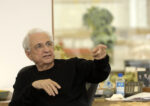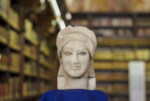Homo Mundus Minor
.jpg)
Ciascun artista gioca con identità costruite socialmente, alterando le forme che le compongono in modo così radicale da esporre la fragilità e vulnerabilità nascoste dietro il loro essere naif.
Comunicato stampa
The exhibition revolves around ideas of constructed identities, social labelling and stereotypes. It brings to the space new and recent artworks by Lucas Blalock, Simon Denny, Maggie Lee, Woody Othello, Hannah Perry, Lui Shtini and Anna Uddenberg. All these artists play with these socially constructed identities, and dramatically alter their forms so to expose the frailty and vulnerability that is hidden behind their naïveté. The creative alteration of social stereotypes that is presented in this group show leads to a multitude of misunderstandings that is precisely what these artists look for in their yet different practices. Indeed, such transformations and subsequent misinterpretations provide those forms, bodies and objects with the possibility of a defence in front of the inquisitive eye of the viewer. Their metamorphosis occurs as a way to safeguard the still unexpressed potentialities of their identities, that may want not to be completely seen, even when they ask to be seen differently.
Lucas Blalock’s photographs of mundane objects blur the line between what is seen and what is real by altering the original image with evident traces of post-production processes that inevitably transform the identity of what is portrayed. In The Sleepers (2016), an empty bed with pillows on one side hosts two lonely and distant bodies, suggested through quick and rough pink digital brushes. Proposing new ways of seeing the ordinary, the artist’ intentional use of Photoshop unfolds as a way to assemble multiple visions in the form of a unique object, and thus manifests Blalock’s painterly approach to photography.
Simon Denny’s new sculpture represents the map of the Free Republic of Liberland, a self-proclaimed libertarian nation supposedly located in a 7 square kilometre delimitation zone under territorial negotiation between Croatia and Serbia. In attempts to look official, Liberland’s public appearance includes its own currency, stamps, a flag and coat of arms. To explicate its (plausible) social activities the artist places on top of the map a second layer showing the winning result of an architecture competition to build on Liberland. Denny’s sculpture seems to ask questions growing ever more urgent in Europe and beyond. How close is libertarianism to the resurgent far-right? What are the implications of ignoring existing geopolitics in pursuit of financial shadow structures? What ground –literal and figurative¬– will techno-libertarians and the far-right share in the near future?
Maggie Lee’s Mommy (2015) is a documentary about the artist’ personal story and the loss of her mother. The story is told in chapters; yet, all the scenes progress, following one another in a restless process of accumulation of videos, photographs, texts, animations and sounds. The chapter titles and mood boards for each sequence was realised through a software program called to.be. Through the assiduous layering of all kinds of imagery, sound, and archival material, Lee wants the viewer to experience the narrative through all senses possible. Lee masters the tension between the projection and the real, the image of what has been and the flesh of what remains.
Othello’s hyper-real ceramic sculptures resemble everyday objects like combs, a soap dish, a door handle, and a towel bar. Depicting the harms and marks outside stimuli have eventually left over these deteriorated items, Othello gives form to physical representation of emotional states. Indeed, the artist always places his sculptures into highly oniric installations that remind of cinematic settings and constructed realities. The hopelessness of Othello’s miserable and grotesque objects tells a story about (quoting the artist) “the strain between outside stimuli conflicting with personal desires’, to such an extent that those objects possibly assume anthropomorphic features.
In Hannah Perry’s film Baby Brain (2016), the conflict arising from social conditioning takes the form of an intimate quest about the self, and how this self may perceive itself as a gendered subject. Hannah’s film is composed by appropriated footage (YouTube, Snapchat) and footage she films herself on different devices depicting her everyday surroundings. Different types of sources are meshed together in the flow of personal narrative: in this case the surrounding is LA and her discovery of a new city whilst going through a breakup is at the centre of the film. All moving images are altered by Perry in older to adapt each sequence to the rhythm of the different sounds featured in the film: the artist’ voice as narrator, field recordings, extracts of conversations about feminist theory and the music Perry composes by herself.
Working in portrait format just in order to subvert its conventions, Lui Shtini creates small paintings whose abstract forms undeniably evoke human features, like faces, moustaches and genitalia. However, these totem-like bodies and figures never reveal completely their identity, swinging between the obvious and the occult. Treating those skins as means of penetrating deeper into one’s psyche, Shtini’s works are meant to elicit a very personal identification of the viewer with the image, forcing whoever looks at them to get lost into the vivid textures that compose them.
Through the feedback loop of consumerist culture Anna Uddenberg investigates how body culture, spirituality, and self-staging are intertwined with the mediation and production of subjectivity by new technologies and forms of circulation. Her practice is a space for reflecting on taste/class, appropriation, and sexuality, which integrates earlier approaches to gender theory while pushing these questions into new and intensively material territories.
Lucas Blalock, Simon Denny, Maggie Lee, Woody Othello, Hannah Perry, Lui Shtini, Anna Uddenberg
Homo Mundus Minor
8 febbraio – 11 marzo 2017
Inaugurazione 7 febbraio 2017, ore 19
Via Ripense 6, Rome
[email protected]
Etichette sociali e realtà artefatte o stereotipate sono oggetto d’indagine di opere inedite e recenti di Lucas Blalock, Simon Denny, Maggie Lee, Woody Othello, Hannah Perry, Lui Shtini e Anna Uddenberg. Ciascun artista gioca con identità costruite socialmente, alterando le forme che le compongono in modo così radicale da esporre la fragilità e vulnerabilità nascoste dietro il loro essere naif. L’alterazione creativa di stereotipi sociali su cui la mostra si basa provoca una moltitudine di fraintendimenti a cui tutti gli artisti coinvolti di fatto aspirano nelle loro pur diverse ricerche. Le trasformazioni in atto, e i conseguenti equivoci che queste opere suggeriscono consentono alle forme, ai corpi e agli oggetti ritratti di ripararsi di fronte allo sguardo intrusivo dei visitatori. La loro è una metamorfosi che sopraggiunge in seguito al tentativo di salvaguardare le ancora inespresse potenzialità delle singole identità, che potrebbero anche non volersi rivelare completamente, pur continuando a chiedere di essere guardate con occhi diversi.
Le fotografie di oggetti quotidiani di Lucas Blalock confondono ciò che si vede con ciò che è reale attraverso evidenti tracce di post-produzione poste sull’immagine originale, così da trasformare inevitabilmente anche l’identità di ciò che viene ritratto. In The Sleepers (2016), un letto vuoto con dei cuscini disposti solo su un lato diviene un giaciglio per due corpi distanti tra loro, visibili solo grazie alle goffe e veloci tracce rose lasciate dal pennello digitale. Suggerendo nuovi modi di guardare l’ordinario, l’artista usa intenzionalmente mezzi come Photoshop per assemblare visioni multiple in un’unica immagine, dando al tempo stesso prova dell’attitudine altamente pittorica con cui affronta la fotografia.
La nuova scultura di Simon Denny rappresenta la mappa della Libera Repubblica di Liberland, una nazione libertaria autoproclamata che si trova presumibilmente in una zona di sette chilometri in fase di negoziazione tra Croazia e Serbia. Nel tentativo di adottare una veste pubblica ufficiale Liberland ha già una propria moneta, francobolli, una bandiera e lo stemma. Per dimostrare l’esistenza di attività sociali nella neonata nazione, l’artista pone una seconda mappa sull’originale: essa raffigura il progetto architettonico vincitore di un recente bando per la colonizzazione di Liberland. La scultura di Denny sembra porre domande sempre più urgenti in Europa e oltre. Quanto vicino è il libertarianismo alla rinascita dell’estrema destra? Quali sono le implicazioni derivanti dall’ignorare l’odierna geopolitica nella ricerca di strutture finanziarie? Quale territorio –in senso letterale e figurato- i Techno-libertariani e la quota di estrema destra condivideranno nel prossimo futuro?
Il film Mommy (2015) di Maggie Lee è un documentario sulla storia personale dell’artista, e sulla perdita della madre. Nonostante sia divisa in capitoli, la storia si sviluppa attraverso un serie di sequenze che si succedono secondo un continuo processo di accumulazione di vari filmati, fotografie, testi, animazioni e suoni. I titoli dei capitoli e le ‘mood boards’ (letteralmente ‘tavole umorali’) che la compongono sono realizzati dall’artista grazie ad un software chiamato to.be. Proprio grazie all’assidua sovrapposizione d’immagini, suoni, umori e svariati materiali d’archivio, Lee fa in modo che lo spettatore si immerga nella narrazione con tutti i suoi sensi. In questo modo, l’artista riesce anche a padroneggiare la tensione tra la proiezione di qualcosa e la sua realtà, tra l’immagine di ciò è stato e la fisicità di ciò che resta.
Le iper-reali sculture in ceramica di Woody Othello ritraggono oggetti quotidiani come un pettine, un porta sapone, una maniglia e un porta asciugamani. Mostrando anche gli urti e le tracce che stimoli esterni hanno lasciato su questi oggetti ormai deteriorati, Othello dà forma a rappresentazioni fisiche di stati emotivi. Infatti, l’artista è solito inserire tali oggetti all’interno d’installazioni fortemente oniriche, reminiscenti di ambienti cinematografici e di realtà costruite. L’essere senza speranza di questi poveri e grotteschi oggetti rivela la loro storia che, secondo le parole dell’artista, parla “della tensione che si crea quando stimoli esterni entrano in conflitto con desideri personali”.
Nel film Baby Brain (016) di Hannah Perry, il conflitto derivante dai condizionamenti sociali prende le forme di un’intima ricerca sul proprio sé, e su come questo sé possa arrivare a percepirsi come un soggetto identificato per il proprio sesso. Il film si compone di un’immersiva sequenza di varie scene ritraenti la quotidianità dell’artista e registrate da lei con diversi strumenti, oppure trovati su YouTube o Snapchat. Questi diversi filmati vengono poi composti all’interno di una narrazione tutta personale: in questo caso, nucleo del film è la visita e scoperta di Los Angeles nel momento in cui l’artista cerca di superare la fine di una relazione. Tutte le immagini sono poi alterate dalla Perry al fine di adattare ogni sequenza al ritmo dei diversi suoni che si sovrappongono nel film: la sua voce nelle veci di narratore, registrazioni di campo, estratti di conversazioni su teorie femministe e la musica che lei stessa compone per i suoi film.
Lavorando per lo più con formati da ritrattistica solo al fine di sabotare la convenzioni del genere, Lui Shtini crea piccoli dipinti le cui forme astratte indubbiamente rievocano fattezze umane, come facce, baffi e genitali. Tuttavia, questi corpi e volti dalle sembianze totemiche non rivelano mai completamente la propria identità, continuando ad oscillare tra l’ovvio e l’occulto. Trattando queste fisicità come mezzi per penetrare nel profondo della psiche, le opere di Shtini sono pensate per suscitare un’identificazione molto personale dello spettatore con l’immagine ritratta, obbligando chiunque guardi queste opere a perdersi nelle dense pennellate che le compongono.
Attraverso un’analisi retroattiva della cultura consumistica Anna Uddenberg indaga il modo in cui la concezione, spiritualità ed esposizione del corpo si mescolano alla produzione della soggettività prodotta dalle nuove tecnologie e dalle nuove forme di diffusione delle notizie. La sua pratica artistica esplora il rapporto tra classe, gusto, e sessualità, e mentre prende in considerazione anche diversi, precedenti studi sulla teoria del gender spinge le domande che li nutrono verso nuovi e intensamente materici territori.



